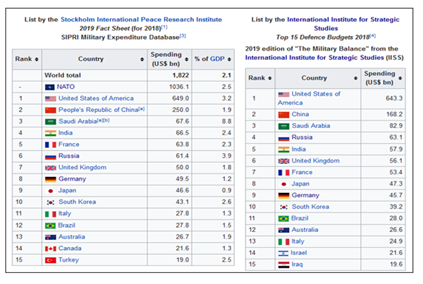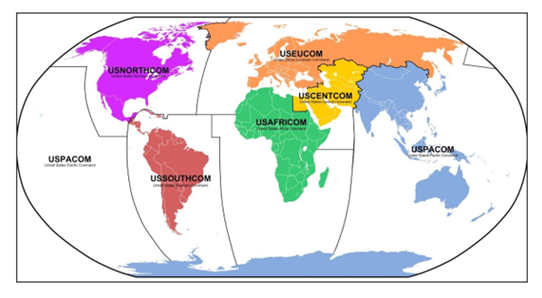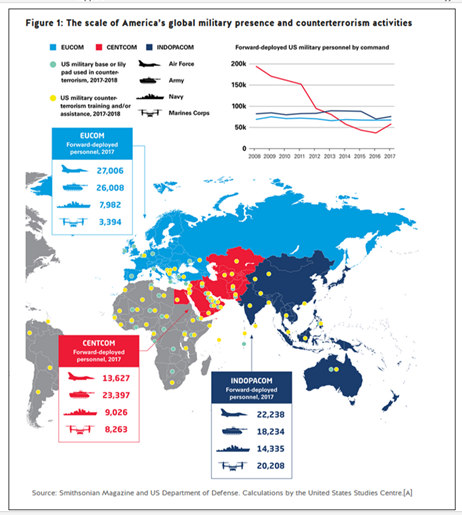Military capability of the US


The first list left above is based on the SIPRI fact sheet which includes a list of the world’s top 15 military spenders in 2018, based on current market exchange rates.
The second list right above is based on the 2019 edition of “The Military Balance” published by the (IISS) using average market exchange rates.
The US superiour military expenditure
Regardless the statistics, the position of the US military expenditure is overwhelmingly number one anyway. This picture has been valid through the whole period of the US unipolarity since 1990. The US defense budget worth of $ 715 billion in 2019 and $ 738 billion in 2020, alone accounts nearly 40% of the world total military spending or as much as next eight biggest together.
In addition, there are huge sums of money for various military purposes in other items of the federal budget system, like The Overseas Contingency Operations (OCO) fund – sometimes referred to as war funds – which is a separate pot of funding (worth of over $ 60 billion) operated by the Department of Defense and the State Department, in addition to their “base” budgets.
The defense spending accounts for almost 16 percent of all federal spending and roughly half of the discretionary spending, the US spending more on national defense than the next eight biggest national defense budgets in the world combined, including China, Saudi Arabia, Russia, United Kingdom, India, France and Japan.
The US government is currently spending at the rate of approximately $ 1,2 trillion per year for all defense-related purposes (actual defense budget, arms development costs, homeland security, international security assistance and tens of other special items).
Since 9/11 terror strike, the US has spent over $ 5 trillion to different wars and other armed conflicts which are still continuing (e.g. Afghanistan, Iraq, Syria, Libya).
Challenges to the US security
According to numerous official US security reports, the US Department of Defense’s enduring mission is to provide combat-credible military forces needed to deter war and protect the security of our nation. Reinforcing America’s traditional tools of diplomacy, the Department provides military options to ensure the President and the US diplomats negotiate from a position of strength.
The central challenge to the US security is the re-emergence of long-term, strategic competition by what the National Security Strategy classifies as revisionist powers. China and Russia want to shape a world consistent with their authoritarian model and are now undermining the international order from within the system by exploiting its benefits while simultaneously undercutting its principles and “rules of the road.”
The security environment is also affected by rapid technological advancements and the changing character of war. States are the principal actors on the global stage, but non-state actors also threaten the security environment with increasingly sophisticated capabilities.
The official US defense objectives include:
- Defending the homeland from attack
- Sustaining Joint Force military advantages, both globally and in key regions
- Deterring adversaries from aggression against our vital interests
- Enabling US interagency counterparts to advance US influence and interests
- Maintaining favorable regional balances of power in the Indo-Pacific, Europe, the Middle East, and the Western Hemisphere
- Defending allies from military aggression and bolstering partners against coercion, and fairly sharing responsibilities for common defense
- Dissuading, preventing, or deterring state adversaries and non-state actors from acquiring, proliferating, or using weapons of mass destruction
- Preventing terrorists from directing or supporting external operations against the US homeland and our citizens, allies, and partners overseas
- Ensuring common domains remain open and free
- Establishing an unmatched twenty-first century National Security Innovation Base that effectively supports Department operations and sustains security and solvency
Global military exposure (worldwide military bases network) of the United States
US military presence around the world has expanded dramatically in the course of the years since the end of the Cold War, in other words along with the unipolarity.
The purpose is to control not only the military threats and interests but supervise natural resources, economic, social and political activities worldwide for the best of the US interests.
The geopolitical outreach of the US is based on the worldwide network of military bases and this installation covers the whole planet (all continents, oceans and the outer space).
The US operates and/or controls some 800 military bases worldwide covering over 150 countries and totaling over 300.000 US military personnel deployed. These bases can broadly be classified under four main categories: Air Force Bases, Army or Land Bases, Naval Bases and Communication/Spy Bases.
These military bases and installations of various kinds are distributed according to a Command structure divided up into six spatial units and four unified Combatant Commands. Each unit is under the Command of a General. The surface of the earth is structured as a wide battlefield, which can be patrolled or steadfastly supervised from the Bases.

Territories under a Command are:
Six spatial units
- the Northern Command (USNORTHCOM) for North America,
- the Pacific Command (USPACOM) for Pacific and Indian oceans, Australia and Asia,
- the Southern Command (USSOUTHCOM) for South America and Antarctica,
- the Central Command (USCENTCOM) for Central Asia, Middle East and Egypt,
- the European Command (USEUCOM) for Europe, Russia and Greenland,
- the African Command (USAFRICOM) for Africa,
Four unified Combatant Commands
- the Joint Forces Command,
- the Special Operations Command,
- the Transportation Command and
- the Strategic Command (STRATCOM).
Pentagon changed the name of the US Pacific Command to US Indo-Pacific Command in the summer 2018.
The NATO has its own network of military bases, thirty in total, which are primarily located in Western Europe.
As to the global deployment of US military troops totaling about 300.000, the rough estimate of regional distribution is the following:
- in Europe: 120.000 from which in Germany 75.000
- in Asia: 100.000, from which 40.000 in Japan and 40.000 in South Korea
- in Middle East: 70.000 US troops, while the rest in Central Asia, Africa and South America

Problems in military-industrial production and products
During last 15 years the US military forces have enjoyed an exceptionally abundant time, ever growing budgets and other allowances. Perhaps due to this abundance, there have been a lot of published failures and problems both in development of new weapons and generally in different production chains regarding the US military-industrial complex.
The following list of some key failure examples illustrate the situation. The list is based on statements, published by American professional military, strategic and technical analysts:
- F-35 fighter jet: number of technical failures and massive over-expenses; the latest technical reports (summer 2019) indicate 13 severe failures and deficiencies still exist
- Littoral Combat Ship project: so far, less capable and more vulnerable than the 30 years old vessels it was supposed to replace
- the Army’s “Commanche” helicopter, an intended replacement for the Apache: the entire program was scrapped after spent $ 10 billion on (PowerPoint?) presentations
- the Army’s Future Combat Systems program: which burned an estimated $ 20 billion up to 2014when cancelled
- Systems failure: new US weapons are too vulnerable to cyberattacks, according to GAO report (US Government Accountability Office, Report October 9, 2018)
- the Navy’s next-generation aircraft carrier, USS Gerald R. Ford: GAO report 2014 tells” poor or unknown reliability of the newly designed EMALS catapults, arresting gear, weapons elevators, and radar, which are all critical for flight operations”, excessive increasing costing, agreed schedule was 2014 but after the latest Shock Test “ the ship could not operate successfully in combat conditions likely until 2025”
- The US military is poorly protected from air threats: THAAD is good only for missile defense, not air defense. Patriot PAC-3 is destined to counter tactical ballistic and cruise missiles but very limited capability against aircraft. Aircraft-capable PAC-1 and PAC-2 are either upgraded to the PAC-3 variant or sold abroad. There is nothing left but short-range shoulder-fired portable Stingers, with a range of 8 km and a maximum altitude of 4 km. Patriot and Aegis air defense systems have low combat efficiency when it comes to counteraction to small-sized air targets like drones and cruise missiles.
- M-1 Abrams tank: new gas turbine engine sensitive to sand and requires prolonged and expensive maintenance
- General assessment of arms development work (annual separate budget approx. $ 70 billion): excessive complexity and too high sophistication as well as typically 200-500% over-expenses in development costs and bureaucratic processes
Excessive military burden and overstressed military forces
Total burden of all military related expenditures has been heavy, at 6% level from GDP, during last ten years. In addition, the impacts of several prolonged wars (Afghanistan, Iraq, Syria) to the American politics, the growing number of war victims (Americans and others), veterans and their healthcare costs, unfunded liabilities of veteran pensions and other military related issues, all are causing growing stress to the American society. Some American analysts have counted that the US has been at war for 225 years of its 242-year history.
After WWII, the main wars/armed conflicts with US involvement have been in Afghanistan (both 1978-1989 and 2001->), Cambodia, Chad, East Timor, Guatemala, Haiti, Indonesia, Iran, Iraq, Korea, Laos, Nicaragua, Pakistan (West-East), Philippines, Sudan, Vietnam and Yugoslavia. The estimate number of killed people exceeds 20 million in these wars.
Recent SIGAR reports (https://www.sigar.mil/quarterlyreports/), regarding the war in Afghanistan entering its nineteenth year, have been revealing. John F. Sopko, the Special Inspector for Afghanistan Reconstruction, testified before Congress in early January 2020 that America’s Afghan War was plagued by “mendacity and lies.”
Sopko states that “After 19 years America admits to itself that it never could have won war in Afghanistan”. The documents paint an unflattering picture of America at war, with the combined military and civilian leadership lacking a viable strategy for victory, leaving successive waves of American servicemen to deploy, fight and return home, having achieved nothing.
Disputes and disagreements with allies in NATO, with Japan and South Korea regarding financial quotas and military involvements are mirroring the growing resistance of other parties to the US military posture.
The major role of the US in “regime change operations” worldwide is apt to increase suspicion and mistrust among both allies and opponents. From the end of WWII to the end of Cold War (1949-1989) the total number of different coups /coup attempts, orchestrated by the US, exceed 40 countries covering all the continents.
Stephen Walt had two critical articles (“The Art of the Regime Change”, “Regime Change for Dummies”) in Foreign Policy, May 2018, regarding regime change operations. He presents nine historical cases of US made regime changes and asks: What does history teach us about regime changes? The answers are pretty obvious, as can be seen from the historical cases: It’s almost always a very bad idea.
John Mearsheimer, in his recent book “The Great Delusion” (2018), makes a clear analysis why American war-addiction has been so extensive in last twenty years. In the period of unipolarity, the US has become so enthusiastic to “liberal hegemony” and its worldwide exporting that forgot nationalism and realism, which still are the most important “isms” in the international politics.
Security related agencies and organizations in the US
There are a great number of security related agencies and organizations, federal and other administrative levels, which produce tens of security reports annually. Some recent reports belonging to this category are, inter alia:
- National Security Strategy 2017 (NSS)
- Worldwide Threat Assessment of the US Intelligence Community 2018 and 2019
- Nuclear Posture Review 2018 (NPR)
- Missile Defense Review 2019 (MDR)
- National Defense Strategy 2018 (NDS)
- National Intelligence Strategy 2019
- Providing for the common defense 2018, The assessment and recommendations of the National Defense Strategy Commission
- Competing in Space, the National Air and Space Intelligence Center (NAIC), December 2018
- Weapon Systems Cyber Security, GAO Report, October 2018
- National Security. Long range emerging threats facing the US as identified by Federal Agencies, December 2018, Report to Congressional Committees, GAO-19-204SP
- Lead Inspector General, Operation Inherent Resolve and other overseas contingency operations, Report to the United States Congress, July 1, 2018 – September 30, 2018
- Averting Crisis: American Strategy, Military Spending and Collective Defense in the Indo-Pacific, The US Studies Center 2019
- Challenges in Space, Defense Intelligence Agency, January 2019
- SIGAR Reports, quarterly published
- Research Reports to US Congress
All these reports confirm the present main threat view of the US, stated already in NSS 2017:
- China and Russia pose the greatest threats to the US in all important issues stated in the reports but especially dangerous are nuclear weapons, cyber threat and space threat (ASAT technology)
- Likewise, Iran and North Korea, as “rogue states”, form the “second class” of threats, which is however more regional and restricted in character
- The concept of “major-power competition and conflict” became again relevant in the post-Cold War period and that situation has been escalating year by year since 2014
Other types of external threat, minor in their importance are:
- weapons of mass destruction and proliferation
- terrorism
- transnational organized crime
- online influence operations
- global health problems: pandemic or large-scale outbreak of contagious diseases
- human displacement (refugee problems)
- religious freedom
- environment and climate change, considered mainly in the framework of the US military
- regional threats, where China, Russia, North Korea, Iran, Syria, Libya, Venezuela and Cuba have “central roles”
This overall view of threats has been valid since 2014 and the three first threats are on highlight display.
When looking at the grand strategy recommendations to the unipole, presented by Monteiro, it seems obvious that the US has chosen a fully opposite grand strategy.
Monteiro recommendated to the rationale unipole a strategy of “defensive accommodation” but the US international behavior has been totally opposite. From early 2010s and very clearly since 2014, the US chose “offensive containment” with extra stark sanctions policy.
Likewise, an active debate even stark arguing is going on regarding the national security, which seems to be an extremely sensitive topic in the American politics and society. Here some excerpts, relevant to the subject of this website:
- MDR 2019 caused a lot of discussions: Supporters of a bigger missile defense capability argue that it improves deterrence by reducing adversaries’ confidence in their ability to launch successful attacks against the US. The opposing argument is that it overlooks the negative effect missile defense has on nuclear stability when other factors are considered.
- The United States has lost its military edge dangerously and could potentially lose a war against China or Russia, according to a report released November 2018 by a bipartisan commission that Congress created to evaluate the Trump administration’s defense strategy
- Heritage Foundation: 2020 Index of US Military Strength: America’s investments in military readiness are paying off, particularly for the Army, but its armed forces would be stretched dangerously thin if they participate in more than one large war at the same time. Counter-arguments to this Index: America’s military is misdirected – not underfunded.
- Heated debate on the Cold War turning to Cold Peace and again to Cold War II, the triangle game of the US – China – Russia; the end of American way of war.
- Lively debate on decision to wreck the aircraft carrier the USS Harry Truman (decade before planned) in 2019 (US still has 10 large carriers), due to China’s heavy missile capability and A2/AD threat to the US naval surface forces. Additional debate, US Navy has nearly no minesweeping or minelaying capability.
- US troops have forgotten basic lessons of electronic warfare and jamming and they are not being forced to relearn them because even major training exercises are unrealistically easy, military and civilian experts warned in October 2019. Especially Russia and China have developed the capabilities forming now a great threat.
- since March 1, 2018 (Putin’s state of union speech), extensive and heated discourse on hypersonic weapons and why the US is so far behind Russia and China


